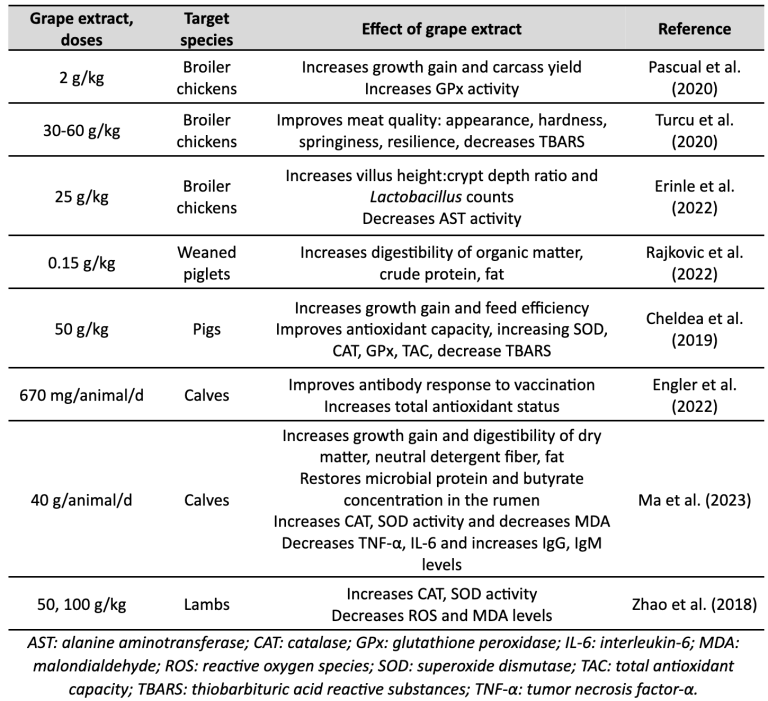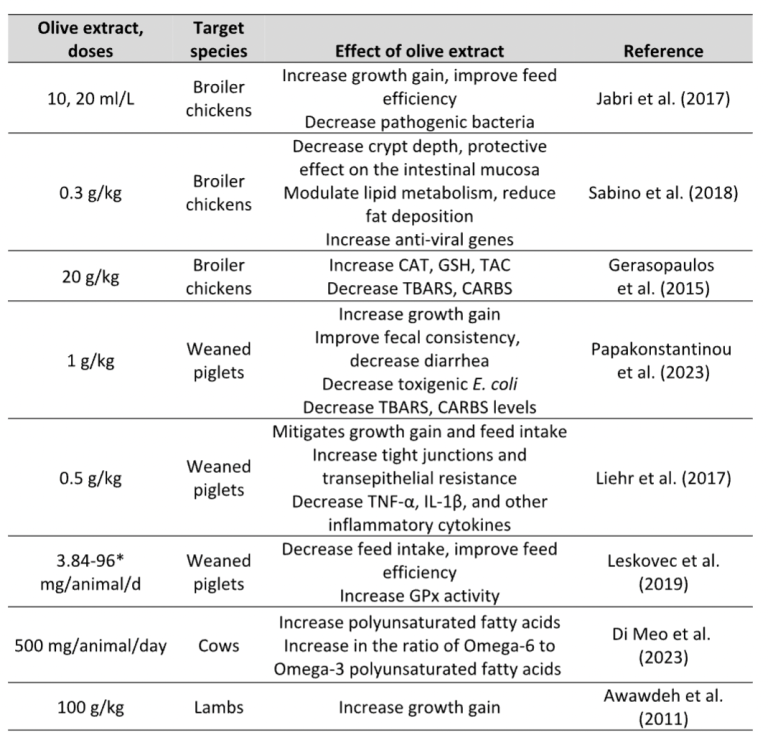Mycotoxins are common natural contaminants of feedstuffs that suppose an important risk for animal health and overall productivity. The intestine is the first defensive barrier towards mycotoxins, hence its alteration can be problematic. The gut disruption leaves the field open for mycotoxins, inducing oxidative stress that negatively impacts on the function of many vital organs. Among them, liver damage should be highlighted due to the key role of liver in many metabolic pathways (Da Silva et al., 2018; Dolenšek et al., 2021; Shanmugasundaram et al., 2023).
Therefore, it is crucial to establish a strategy in order to enhance the animal health and productivity, mitigating the mycotoxins challenge. Globally, phytogenic feed supplements, which are rich in polyphenolic compounds, have raised the attention of producers to promote sustainable practices. Their content of secondary metabolites, including polyphenols, exerts a wide range of favorable effects due to their immunomodulatory, anti-inflammatory, antioxidant, antimicrobial and detoxification activities (Abdel-Moneim et al., 2020).
Grapes and olives are fruits mainly originated from the Mediterranean region that contain a wide variety of phenolic compounds. Furthermore, their beneficial effects are anciently well-described, even in human health. Therefore, the dietary inclusion of plants extracts based on both fruits has a deep demonstration of effectiveness to address the challenges arising in different animal production phases.
Grape extract
The grape (Vitis vinifera L.) is one of the largest fruit crops in the world, and the use of its by-products promotes a sustainable production. Prominent among the broad range of polyphenols contained, there are flavonols including monomers of catechin and its isomer epicatechin, procyanidins, as well as anthocyanins and non-flavonoids as resveratrol and proanthocyanidins. Hence, it has been demonstrated that grape extract offers a wide range of health benefits in animal nutrition (Table 1).
Table 1. Effects of grape extract on animal health

The use of grape by-products in animal nutrition effectively promotes the gut health, improving the intestinal morphology and microbial population. Some studies revealed that the grape extract increases the number of beneficial species like Lactobacillus and Enterococcus, and decreases harmful species like Clostridium and E. coli (Viveros et al., 2011; Hajati et al., 2015; Fiesel et al., 2014; Abu Hafsa et al., 2018). Furthermore, the bacterial fermentation in the intestine and the rumen has been improved (Ma et al., 2023).
In addition, the activation of Nrf2 factor and the reduction of BAX/Bcl2 ratio and caspase 3 activity, as well as the inhibition of MAPK p38 pathway and pro-inflammatory cytokines, enhance the gut health, even in the challenging phases of the animal production (Byun et al., 2010; Filocamo et al., 2015; Sireesh et al., 2017). In fact, Engler et al. (2022) demonstrated that dietary grape supplementation improved the immune response after vaccination.
Likewise, several studies demonstrate the antioxidant capacity of grape extracts by increasing the levels of various antioxidant enzymes including SOD, CAT, GSH-Px, GST, and GSH. Taranu et al. (2019) observed an effective restoration of the antioxidant enzyme activity, counteracting the oxidative damage caused by mycotoxins. This antioxidant capacity promotes the cell viability improving the organism metabolism, including the liver, and reducing lipid oxidation. Consequently, higher nutrient digestibility has been observed resulting in better performance parameters and meat quality (Brenes et al., 2008; Chamorro et al., 2015; Tucu et al., 2020).
Olive extract
The olive industry has increased in recent years due to the worldwide rise in olive oil consumption (Habeeb et al., 2017). Therefore, a considerable quantity of by-products is generated. The use of these by-products in livestock diets promotes “zero waste” production (Herrero, 2020) by minimizing their cost: it can mitigate climate change by reducing the environmental burden of waste and protecting other natural resources (Tzamaloukas et al., 2021).
The olive (Olea europea) is rich in polyphenols, such as oleuropein and hydroxytyrosol, and triterpenes including oleanolic and maslinic acids, among other bioactive compounds that provide much health promoting effects (Herrero, 2020) (Table 2).
Table 2. Effects of olive extract in animal health

The incorporation of olive by-products in animal diets promotes the intestinal integrity. In fact, olive extracts improve the gut morphology, leading to better nutrient digestibility and limiting intestinal dysbiosis. Also, ruminal and intestinal fermentation are positively influenced by the bioactive compounds contained in the olive (Liehr et al., 2017; Marcos et al., 2019).
The role of grape and olive extracts in mitigating mycotoxins
Facing the mycotoxins challenge in animal production, it is well known that the most commonly used procedure is the addition of adsorbent to reduce toxin absorption and distribution to blood and target organs (Vázquez-Durán et al., 2022). In this context, low-cost agro by-products, such as grape and olive extracts, were studied as biosorbents. The efficient adsorption of grape and olive extracts was in vitro demonstrated against some of the most prevalent mycotoxins, including AFB1, ZEN and OTA (Fernándes et al., 2019). Some authors observed that the mycotoxin-binding efficacy of grape by-products is rapid and simultaneous against different mycotoxins due to the presence of micronized fibers and phenolic compounds (Avantaggiato et al., 2014; Vázquez-Durán et al., 2022). In the same line, a reduction in the gastrointestinal absorption of several mycotoxins was described in pigs (Gambaco et al., 2016). This mycotoxin adsorption efficacy is an additional way to value these by-products as solutions to mitigate the mycotoxin challenge.
Grape and olive extract, a promising approach for animal nutrition
Finally, recent research reported beneficial effects of grape and olive extracts due to the modulation of similar metabolic pathways. In turn, they counteract the harmful effects of mycotoxins (Abdel-Razek et al., 2017; Taranu et al., 2019).
Hence, the combination of both phytogenic ingredients is a promising strategy to achieve better performance and efficiency, mitigating the mycotoxins challenge in a sustainable production.



